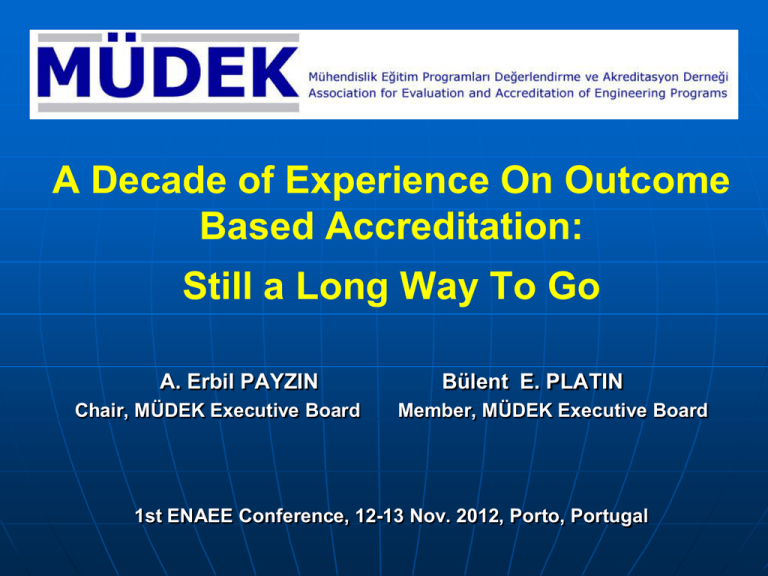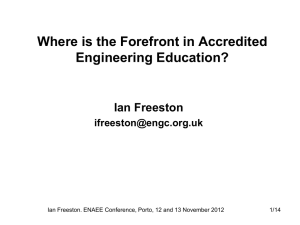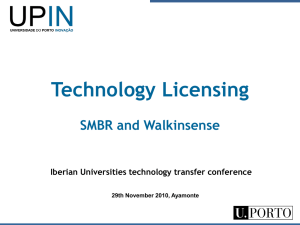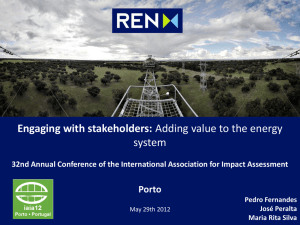Payzin
advertisement

A Decade of Experience On Outcome Based Accreditation: Still a Long Way To Go A. Erbil PAYZIN Chair, MÜDEK Executive Board Bülent E. PLATIN Member, MÜDEK Executive Board 1st ENAEE Conference, 12-13 Nov. 2012, Porto, Portugal Presentation Outline 1. Background information on MÜDEK and its accreditation process 2. Overview of MÜDEK evaluation criteria 3. Most frequently observed shrotcomings in meeting MÜDEK evaluation criteria 4. MÜDEK actions for helping HEIs 5. Conclusions 1st ENAEE Conference, 12-13 Nov. 2012, Porto, Portugal 1 Backgound Information on MÜDEK • Founded in 2002 • A totally independent Non-Governmental Organization (Association) • Evaluates & accredits engineering programmes in Turkey • Uses an outcome-based accreditation process • Authorized to deliver EUR-ACE (FC) Label (2009) • Washington Accord Signatory (2011) 1st ENAEE Conference, 12-13 Nov. 2012, Porto, Portugal 2 MÜDEK Accreditation Process Highlights • Application for accreditation is voluntary • MÜDEK charges a fee for each program it evaluates • Accreditation process, criteria and procedures are pre-defined and publicly available from http://www.mudek.org.tr/ • Starts with a self-assessment report from the HEI for each program to be accredited • External assessment by ad-hoc evaluation teams • Includes 3 day visit to the HEI • MÜDEK takes accreditation action; sends the decision results and the evaluation report to the HEI • Requires periodic re-evaluation (maximum 5 years) • Shorter (2 year) interim evaluations as required • HEI’s can appeal to MÜDEK and request re-evaluations and re-visits 1st ENAEE Conference, 12-13 Nov. 2012, Porto, Portugal 3 MÜDEK Programme Evaluation and Accreditation Activities (as of 30.06.2012) Programmes (FC) Total Quantity (2003-2012) Cum. no. of different HEIs involved 22 Cum. no. of different engineering disciplines 17 Cum. no. of programme evaluations performed 281 (97) Cum. no. of programmes accredited 151 [112] Cum. no. of programmes that received the EURACE Label ( ) interim evaluations 145 [ ] Short term (1-2 year) 1st ENAEE Conference, 12-13 Nov. 2012, Porto, Portugal 4 MÜDEK Evaluation Criteria Criterion 5 Criterion 6 Curriculum Faculty Members Criterion 7 Facilities Criterion 4 Continuous Improvement Criterion 1 PROGRAM Students Criterion 8 Criterion 9 Financial Resources Organization Discipline Decision Specific Making Criteria Processes Institutional Support Criterion 10 Criterion 3 Criterion 2 Program Outcomes Program Educational Objectives 1st ENAEE Conference, 12-13 Nov. 2012, Porto, Portugal Most Frequently Observed Shortcomings in Meeting MÜDEK Evaluation Criteria 1. 2. 3. 4. 5. 6. 7. 8. 9. 10. Students Programme Educational Objectives Programme Outcomes Continuous Improvement Curriculum (major design experience component) Faculty Members Facilities Institutional Support and Financial Resources Organization and Decision-Making Processes Discipline-Specific Criteria 1st ENAEE Conference, 12-13 Nov. 2012, Porto, Portugal 6 Some Definitions • Program Educational Objectives: General statements defining the career goals and professional accomplishments that graduates are expected to achieve in the years following graduation. • Program Outcomes: Statements defining the knowledge, skills, and attitudes that students must have acquired by the time they graduate. 1st ENAEE Conference, 12-13 Nov. 2012, Porto, Portugal 7 Most frequent shortcomings(*) regarding MÜDEK Criterion 2: Program Educational Objectives Nature of Shortcoming % Program educational objectives have not been defined properly (in most cases program outcomes statements have been used as program objectives) 56 Program outcomes have been defined with no or very limited consultation with stakeholders A process for assessing the achievement of educational objectives is not in place or not being operated 31 60 (*) Based on 70 general reviews conducted in 2010-2011 & 2011-2012) 1st ENAEE Conference, 12-13 Nov. 2012, Porto, Portugal 8 MÜDEK Programme Outcomes MÜDEK criteria for programme outcomes meet the requirements of the following standards: o National Qualifications Framework for Higher Education in Turkey (NQF-HETR): Level Descriptors for 6 th Level (Bachelor’s) Engineering Programmes (academic weighted) o EUR-ACE First Cycle Programme Outcomes o Washington Accord Graduate Attributes 1st ENAEE Conference, 12-13 Nov. 2012, Porto, Portugal 9 MÜDEK Programme Outcomes (Criteria 3) 1. Adequate knowledge in mathematics, science and engineering subjects pertaining to the relevant discipline; ability to use theoretical and applied information in these areas to model and solve engineering problems. 2. Ability to identify, formulate, and solve complex engineering problems; ability to select and apply proper analysis and modelling methods for this purpose. 3. Ability to design a complex system, process, device or product under realistic constraints and conditions, in such a way so as to meet the desired result; ability to apply modern design methods for this purpose. (Realistic constraints and conditions may include factors such as economic and environmental issues, sustainability, manufacturability, ethics, health, safety issues, and social and political issues according to the nature of the design.) 1st ENAEE Conference, 12-13 Nov. 2012, Porto, Portugal 10 MÜDEK Programme Outcomes (Criteria 3) Continued: 4. Ability to devise, select, and use modern techniques and tools needed for engineering practice; ability to employ information technologies effectively. 5. Ability to design and conduct experiments, gather data, analyze and interpret results for investigating engineering problems. 6. Ability to work efficiently in intra-disciplinary and multi-disciplinary teams; ability to work individually. 7. Ability to communicate effectively in Turkish, both orally and in writing; knowledge of a minimum of one foreign language. 1st ENAEE Conference, 12-13 Nov. 2012, Porto, Portugal 11 MÜDEK Programme Outcomes (Criteria 3) Continued: 8. Recognition of the need for lifelong learning; ability to access information, to follow developments in science and technology, and to continue to educate him/herself. 9. Awareness of professional and ethical responsibility. 10. Information about business life practices such as project management, risk management, and change management; awareness of entrepreneurship, innovation, and sustainable development. 11. Knowledge about contemporary issues and the global and societal effects of engineering practices on health, environment, and safety; awareness of the legal consequences of engineering solutions. 1st ENAEE Conference, 12-13 Nov. 2012, Porto, Portugal 12 Most frequent shortcomings (*) regarding MÜDEK Criterion 3: Program Outcomes Shortcomings related to formulation and assesment of programme outcomes: % Intended program outcomes do not fully cover the mandatory MÜDEK outcomes (Formulation) 18 Insufficient assessment process is used for determining the extent of achievement of program outcomes by the students. (Usually only surveys or passing grades in courses are being used) (assessment) Insufficient evidence is provided to demonstrate that the students have achieved the program outcomes by the time they graduate (evidence) 41 26 (*) Based on 70 general reviews conducted in 2010-2011 & 2011-2012) 1st ENAEE Conference, 12-13 Nov. 2012, Porto, Portugal 13 Most frequent shortcomings (*) regarding MÜDEK Criterion 3: Program Outcomes (continued) Shortcomings related to particular outcomes: Lack of evidence demonstrating that the students have acquired the ability to design a complex system, process, device or product under realistic constraints and conditions, in such a way so as to meet the desired result; ability to apply modern design methods for this purpose (outcome 3) Lack of evidence demonstrating that the students have acquired the ability to work efficiently in intra-disciplinary and multi-disciplinary teams (outcome 6) % 18 10 (*) Based on 70 general reviews conducted in 2010-2011 & 2011-2012) 1st ENAEE Conference, 12-13 Nov. 2012, Porto, Portugal 14 MÜDEK Actions for Helping HEIs • MÜDEK does NOT provide solutions or consultation sevices • MÜDEK DOES try to increase awareness: o Stressing those frequently observed shortcomings in MÜDEK training workshops for HEIs. o Making presentations on frequently observed shortcomings in Engineering Deans Council meetings o Publishing papers and making presentations in conferences on engineering education, addressing these shortcomings 1st ENAEE Conference, 12-13 Nov. 2012, Porto, Portugal 15 Conclusions • Changing from an inputs-based education system to an outcomes-based one is not easy and takes years. • Main challanges for HEIs are: o Defining the programme eduactional objectives of the programme properly before designing the programme itself. o Developing proper processes for assesing the achievement of programme educational objectives and programme outcomes • Fortunately, vast majority of the programs exhibiting these shortcomings demonstrate full compliance to MÜDEK evaluation criteria during the interim evaluations at the end of the two-year follow up period. 1st ENAEE Conference, 12-13 Nov. 2012, Porto, Portugal 16 Thank you MÜDEK Association for Evaluation and Accreditation of Engineering Programs Zincirlidere cad. No:86 Mericoglu Plaza Daire:4 Esentepe,Sisli, 34394 Istanbul, Turkey Tel.: +90 212 211 02 81 / 82 Fax: +90 212 211 02 89 e-mail: infos@mudek.org.tr http://www.mudek.org.tr/ 1st ENAEE Conference, 12-13 Nov. 2012, Porto, Portugal 17







